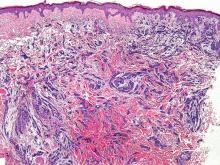What’s Your Diagnosis?
A 57-year-old woman hospitalized for nausea and hyponatremia reported having a pruritic groin rash for a week. Topical triamcinolone prescribed by her primary care physician had not helped the rash. She had a history of hereditary nonpolyposis colon cancer with metastases and stage IIa endometrial cancer. On her lower abdomen and inguinal region, clinicians could see peristomal, indurated, smooth, light pink papules and nodules coalescing into plaques.
Diagnosis: Cutaneous Colon Cancer
The patient’s history of metastatic colon cancer should have been a clue to prevent clinicians from mistaking her rash for eczema and prescribing triamcinolone.
Cutaneous metastases from internal malignancies account for approximately 2% of all skin tumors and are the first sign of internal disease in up to 22% of cases, noted Dr. Jamie Zussman, who submitted the case for discussion at the annual meeting of the Pacific Dermatologic Association.
Colon cancer is believed to metastasize to the skin in 4% of cases, which is what happened in this patient.
A preponderance of skin changes adjacent to the patient’s abdominal incision from previous surgery raises the possibility of direct inoculation of tumor cells during her surgical resection, added Dr. Zussman of the University of California, Los Angeles.
This case illustrates the importance of primary care physicians consulting early with dermatologists when unusual skin eruptions appear in ill patients, she said.
Dr. Scott Binder, who discussed the case at the meeting, put it more bluntly. "People weren’t paying attention to the clinical history," said Dr. Binder also of UCLA. "This woman had a complicated history, but if someone had read her history, they would have figured it out."
Finally, a dermatologist took a biopsy of the rash. Hematoxylin and eosin (H&E) staining showed dermis and subcutis localization, epithelial cells forming glandular structures, and perineural invasion. Cellular pleomorphism also could be seen, plus hyperchromatic, mitotically active atypical nuclei.
Immunohistochemistry showed reactivity for cytokeratin (CK) 20 and CDX2 protein, but was negative for CK7. "CDX2 is an extremely specific marker for colon cancer or GI cancers in general. A case that’s negative for CK7 and positive for CK20 is most likely colon carcinoma until proven otherwise," Dr. Binder said.
Two other immunostains have made a huge difference in the past 3-4 years in differentiating primary cutaneous carcinoma from other tumors, he added. "Immunostains for CK 5/6 and p63 have changed my practice. Get to know them," Dr. Binder said. Almost all metastases stain negative for CK 5/6 and p63, so if CK 5/6 and p63 are positive, it is probably primary skin carcinoma.
"This has been a revolution for dermatopathology," Dr. Binder said. "I talked to people at other cancer centers, and they’re finding that this is indeed useful," he added.
Breast cancer is the most common internal malignancy to metastasize to the skin, followed by lung cancer, colorectal cancer, and others. Approximately 4% of colon cancers metastasize to the skin, most frequently at abdominal sites or the hair-bearing areas of the scalp, neck, or face.
Cutaneous metastases can be classified as locoregional, in-transit, or distant. They may occur through direct invasion, lymphatic or hematogenous spread, or inoculation during surgical procedures.
Now that patients with internal malignancies are living longer and their treatment is more successful (at least in the short and intermediate term), approximately 5%-10% are developing cutaneous metastases, Dr. Binder said.
"I’ve seen two cases in the last year of metastatic renal cell carcinoma that have classically metastasized to the head and neck and that was the first diagnosis. I’ve also seen a case of metastatic lung carcinoma that metastasized to the chest wall that was also not suspected," he said.
Cutaneous metastases confer a poor prognosis and should trigger additional studies to look for metastatic disease in other organs, Dr. Zussman noted. Treatment is mainly palliative, and expectation of survival drops below 1 year once cutaneous metastases of internal malignancy appears.
Dr. Zussman and Dr. Binder reported having no pertinent conflicts of interest.



